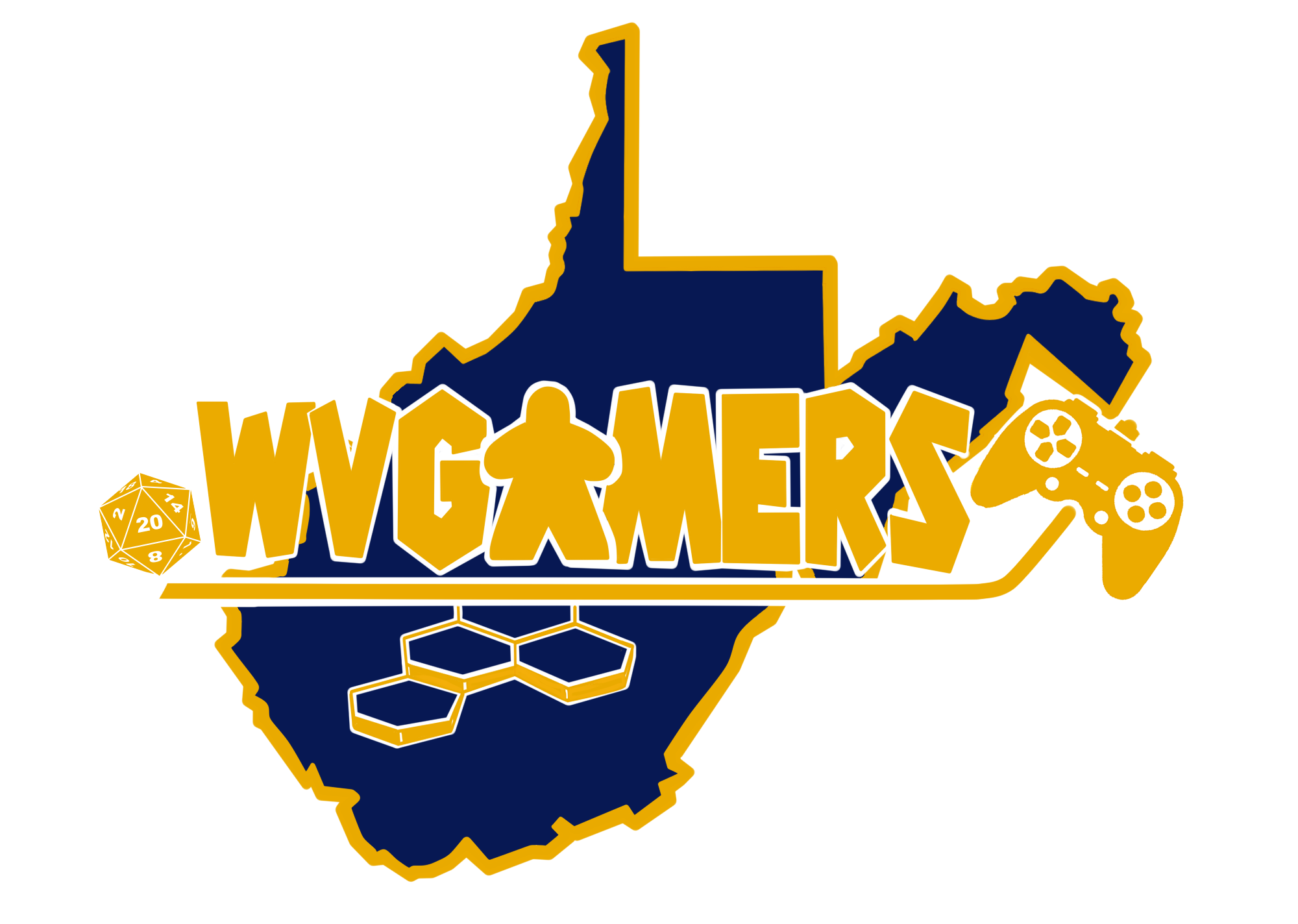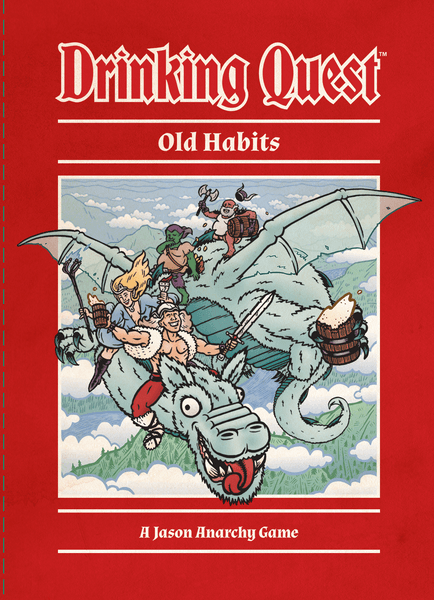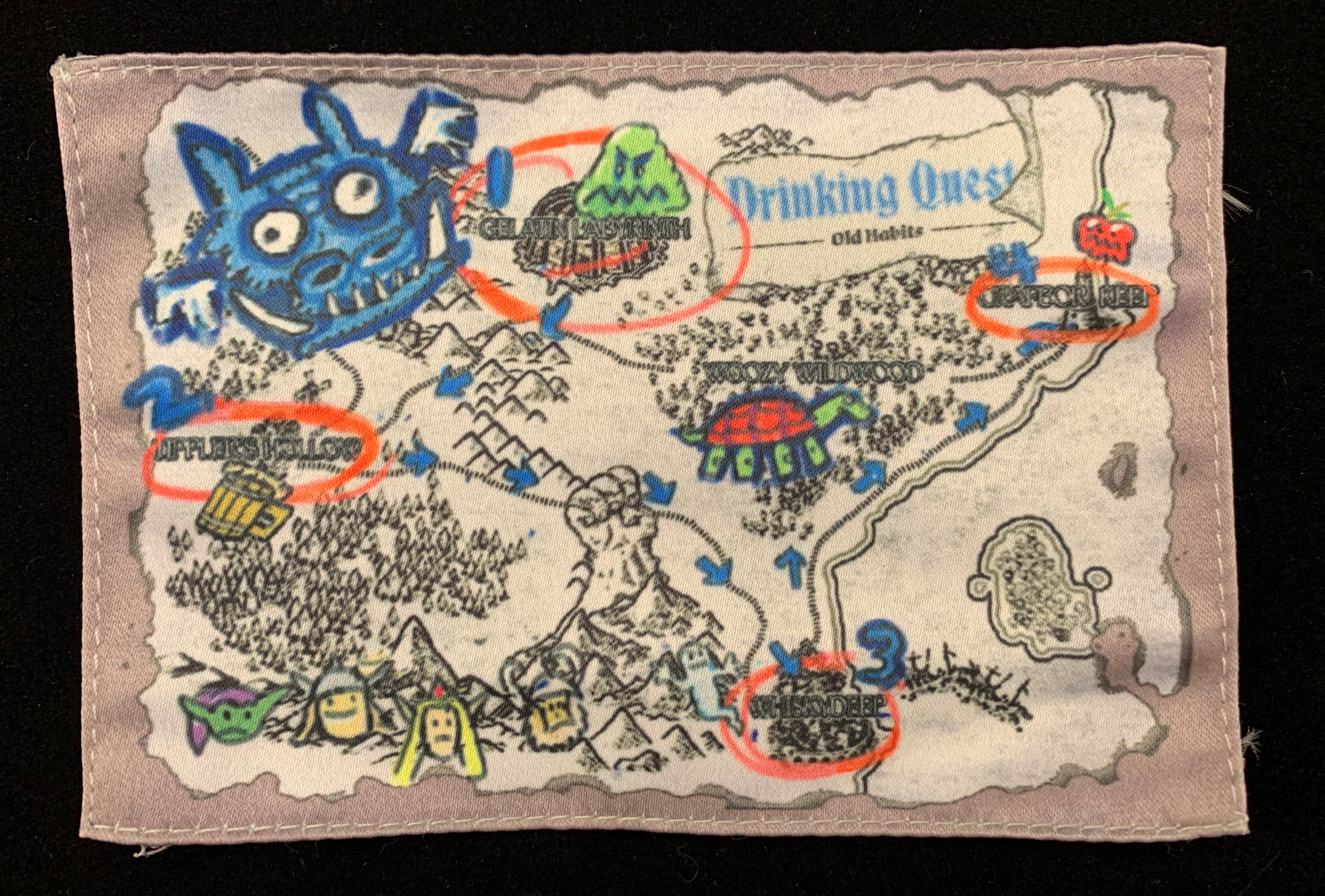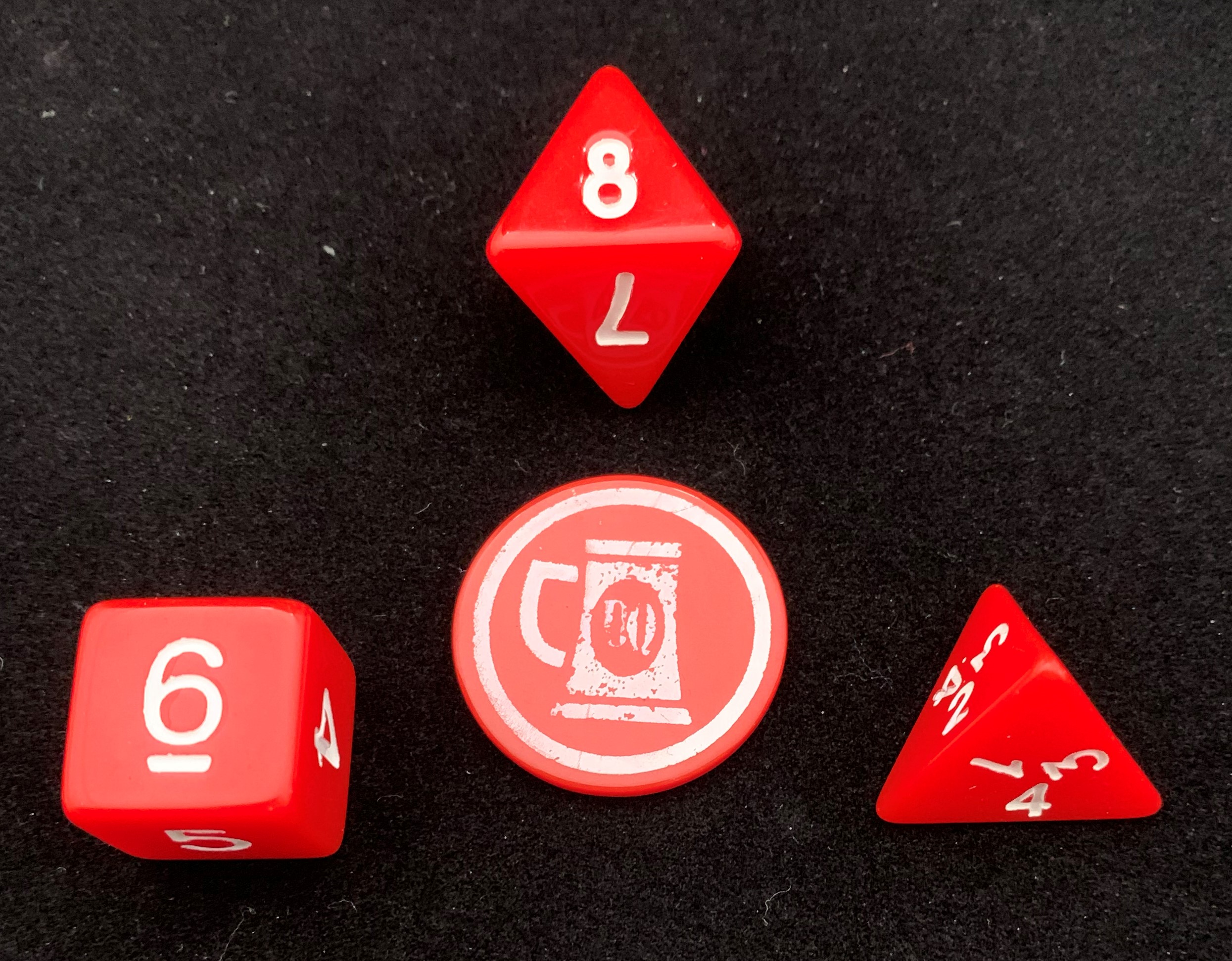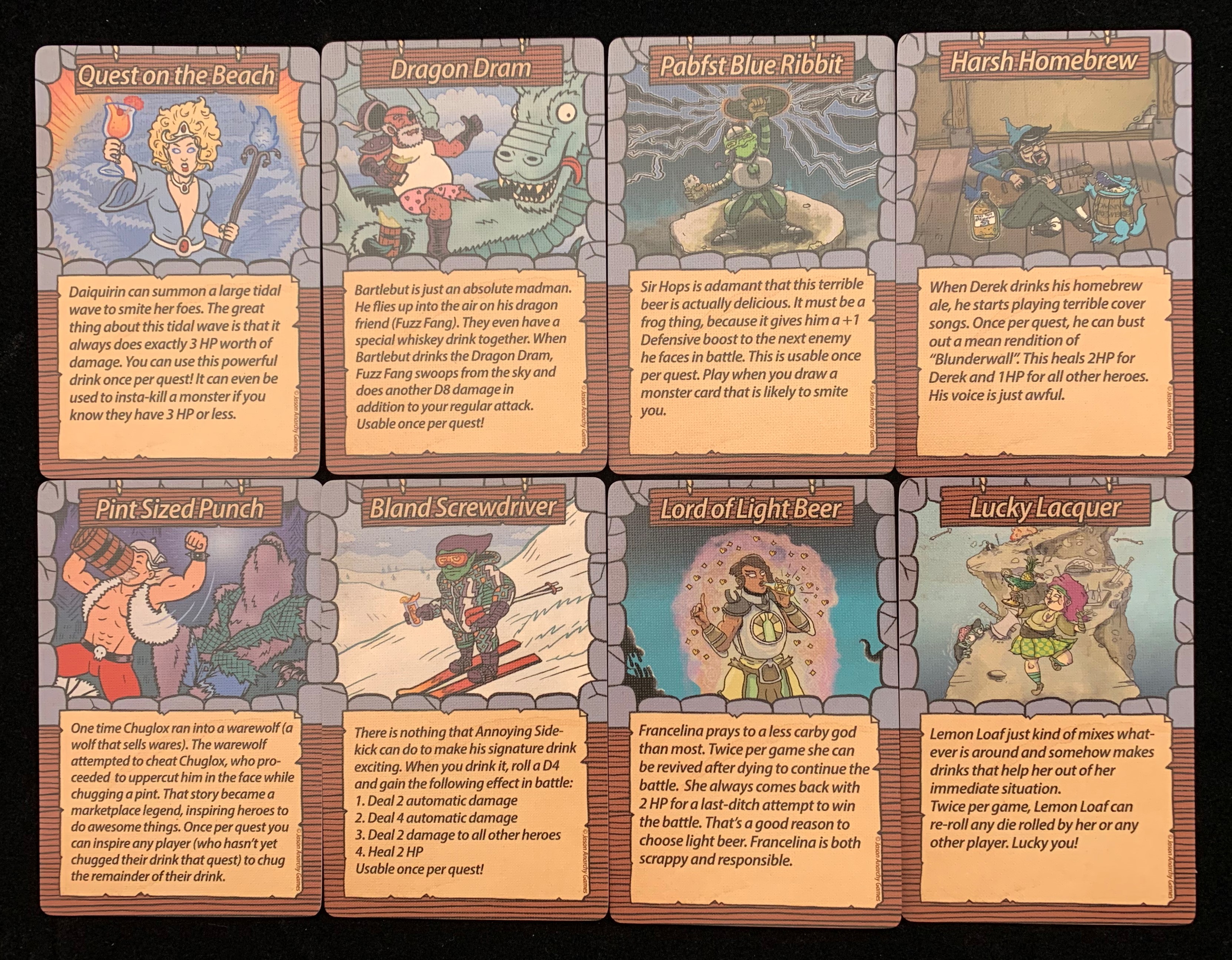In this game, your adventurers aren't the only ones who can enjoy a drink or three.
| Drinking Quest: Old Habits (2020) | |||||
| Designer(s) | Jason Anarchy | Artist(s) |
Zack Schuster, Gaelen Adric Izatt-Galloway III |
Publisher |
Jason Anarchy Games |
| 2-4 | 21+ | 60-120m | |||
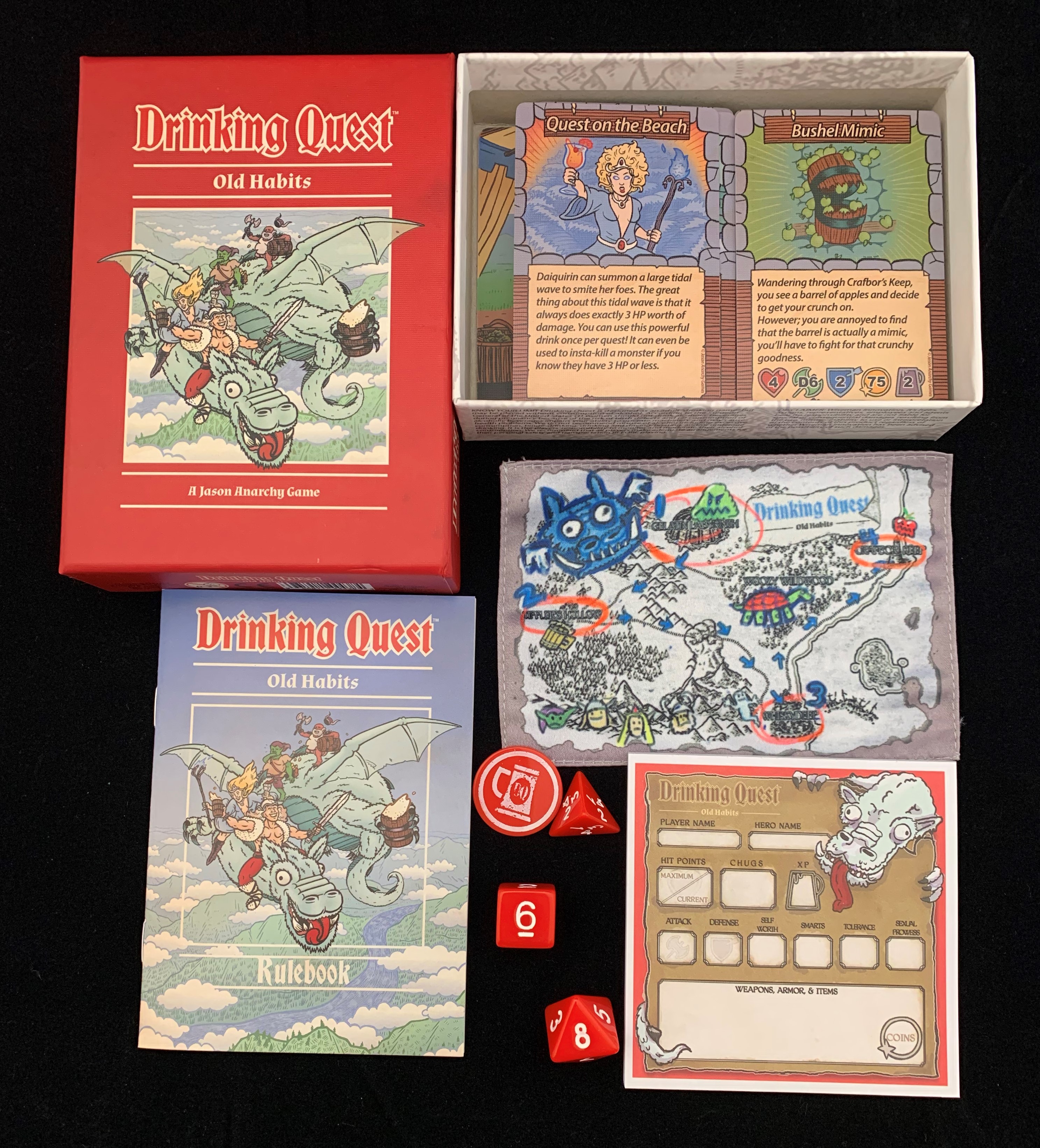 While plenty of tabletop roleplaying game (RPG) sessions tend to have alcohol present, few games incorporate it into their ruleset. Drinking Quest is a light weight series of RPG-like games where failure for your adventurer results in drinks for you. Inspired by versions of RPGs from the 70/80's, Drinking Quest tosses players into familiar settings with humor and fun by completing numbered Quest Decks. Roll some dice, look at the target numbers, and enjoy loot if you success or the drink heading to your stomach if you fail. There are a few games in the series, but we were provided the "Old Habits" box so that is what my review will focus on. If we get a copy of the other boxes at some point, we will cover those and provide an overview of the differences they offer.
While plenty of tabletop roleplaying game (RPG) sessions tend to have alcohol present, few games incorporate it into their ruleset. Drinking Quest is a light weight series of RPG-like games where failure for your adventurer results in drinks for you. Inspired by versions of RPGs from the 70/80's, Drinking Quest tosses players into familiar settings with humor and fun by completing numbered Quest Decks. Roll some dice, look at the target numbers, and enjoy loot if you success or the drink heading to your stomach if you fail. There are a few games in the series, but we were provided the "Old Habits" box so that is what my review will focus on. If we get a copy of the other boxes at some point, we will cover those and provide an overview of the differences they offer.
Drinking Disclaimer
This game is obviously themed to be played while consuming alcohol, but there is nothing that requires this. Players should decide for themselves what the terms will be of their drinking during the game and what their travel plans are after the game; players may skip alcohol entirely opting for non-alcoholic drinks instead. The game even includes some fun bladder related challenges that could be interesting for non-alcohol sessions. The goal is to have fun and ensure everyone is safe afterwards.
Box and Components
The game is packed nicely into a small red box that has the appearance of old Dungeons and Dragons (D&D) books; I think this is a clever way to market the game since it is clearly targeting that demographic. Based on the short rulebook and the description on the back of the box, it is obvious this is meant to be a very easy game anyone can pick up and learn during a gathering that will involve a lot of drinking. The game includes the following components:
- 6 Quest Decks each containing 12 Cards: Players will playthrough these quest cards taking on events and enemies.
- Quest 1: Slime Quest
- Quest 2: OktoberQuest
- Quest 3: Wights at WhiskeyDeep
- Quest 4: Crafbor's Keep
- Bonus Quest 5: Sober Up PSAs
- Bonus Quest 0: High Fantasy
- 40 Character Sheets: Small characters sheets to keep track of your progress in the game; you may need to make copies of these since there is only 40, which is good for about 10 sessions at the max player count.
- 8 Hero Cards: Unlike a traditional RPG, you have pre-made characters you will be using. The Hero cards provide you the details to fill out your character sheet. Four of these heroes were unlocked via the game's Kickstarter campaign.
- 8 Signature Drink Cards: These provide each player a special ability that can be used during the game. Each are tied to a specific character.
- 3 Dice (D4, D6, D8): It is an RPG so there are dice to be rolled to determine whether checks are successful or not. "D#" represents the number of sides on the dice; D6 is your traditional six sided-die.
- Cloth Map: A small map of the world printed on a nice bit of cloth. It shows where each of the numbered quests take part.
- Large Shop Card: Throughout the game, players will be able to buy weapons and one-use items; this large card contains the list of buyable gear.
- Plastic Coin Token: This is used for one of the shop items that can be purchased.
- Rulebook
For a small game like this, I was really impressed to find it uses linen card stock, which makes the cards feel great and was unlocked during the Kickstarter campaign. The artwork and theme is very targeted towards people who appreciate the old style D&D; so there will be some innuendos with some of the artwork and theme of the cards. Again, this is very targeted towards a specific group who will enjoy all of this. However, there are some who will not enjoy it, which is perfectly fine.
I do like the included cloth map; it is certainly not needed but is a nice addition. The rest of the components included are nice and perfectly suitable for the game.
Mechanics
This game streamlines the RPG mechanics typically found in D&D and focuses on quick, easy to learn fun. Much of the challenges will simply require rolling the three provided dice and adding one or two numbers to that to overcome a target number or dwindle down the enemies health.
The goal of the game is to earn the most XP to become the Drinking Champion!!!
Setup
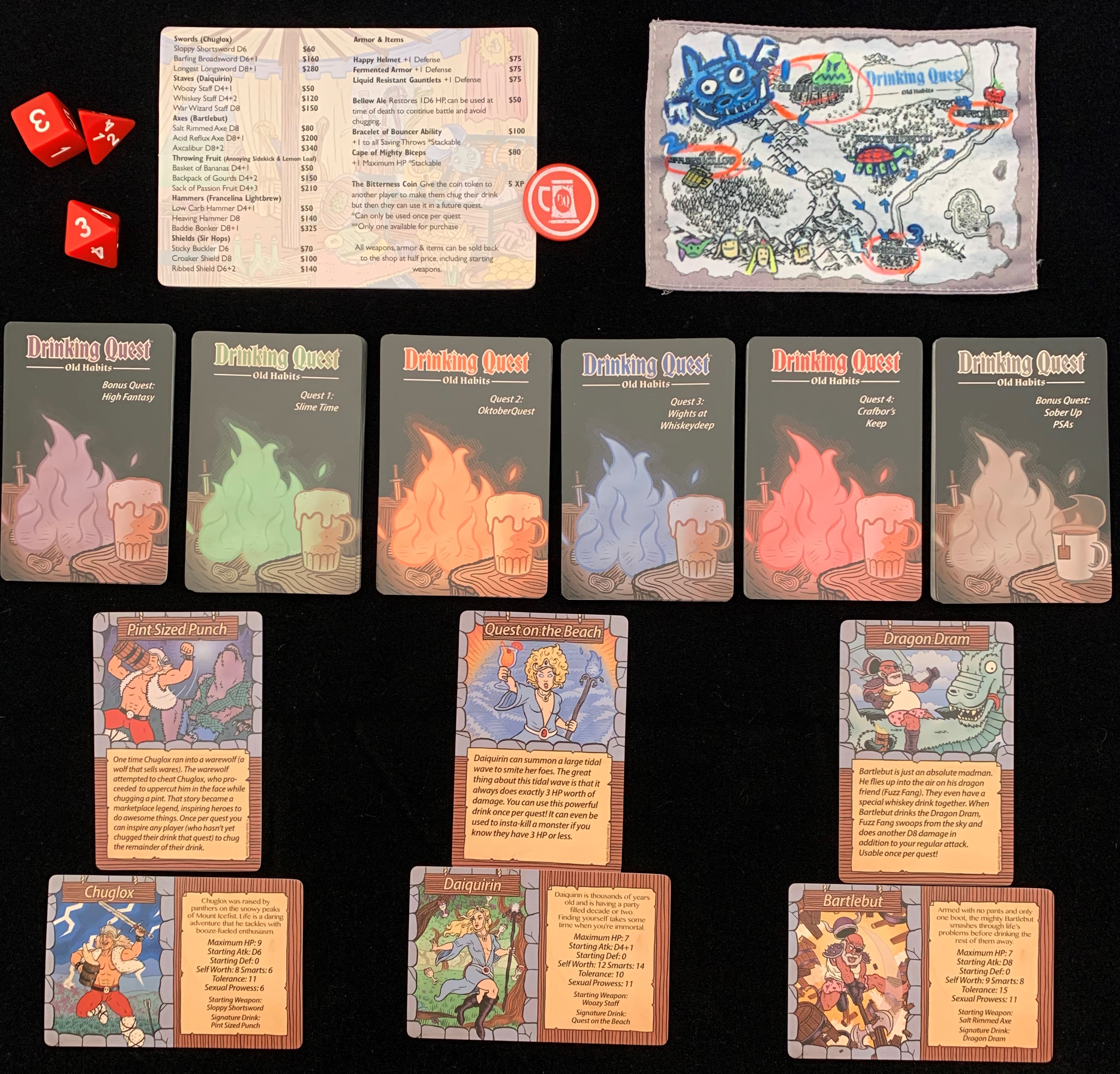 The four numbered quest decks are intended to be played from Quest Deck 1 through 4 as they get more difficult and will really expect the players to have upgraded their equipment throughout the earlier quests. The High Fantasy Deck is essentially a Quest Deck 0 and is optionally played before Deck 1. Likewise, Sober Up Deck is an optional Quest 5.
The four numbered quest decks are intended to be played from Quest Deck 1 through 4 as they get more difficult and will really expect the players to have upgraded their equipment throughout the earlier quests. The High Fantasy Deck is essentially a Quest Deck 0 and is optionally played before Deck 1. Likewise, Sober Up Deck is an optional Quest 5.
- Separate the quest decks and shuffle them individually. Keep them separated but lined up from the starting to ending quest.
- In a 2 player game, cut down each deck to eight cards removing the extra four cards from this playthrough.
- Provide each player a character sheet, a Hero Card, and their matching Signature Drink Card. This can be done by manual selection or dealt randomly. Players will fill out their character sheet with the details from the provided cards.
- Layout the Map, Shop Card, dice, and coin in reach of all players.
Before starting each quest deck, read the quest intro from the back of the rulebook. The player who most recently made a mixed drink goes first; alternatively, select the first player by your preferred method.
Game Flow
Each player will heal and shop in between Quest Decks and then alternate taking on Quest Cards by drawing and resolving the drawn card effects.
- Shopping (optional)
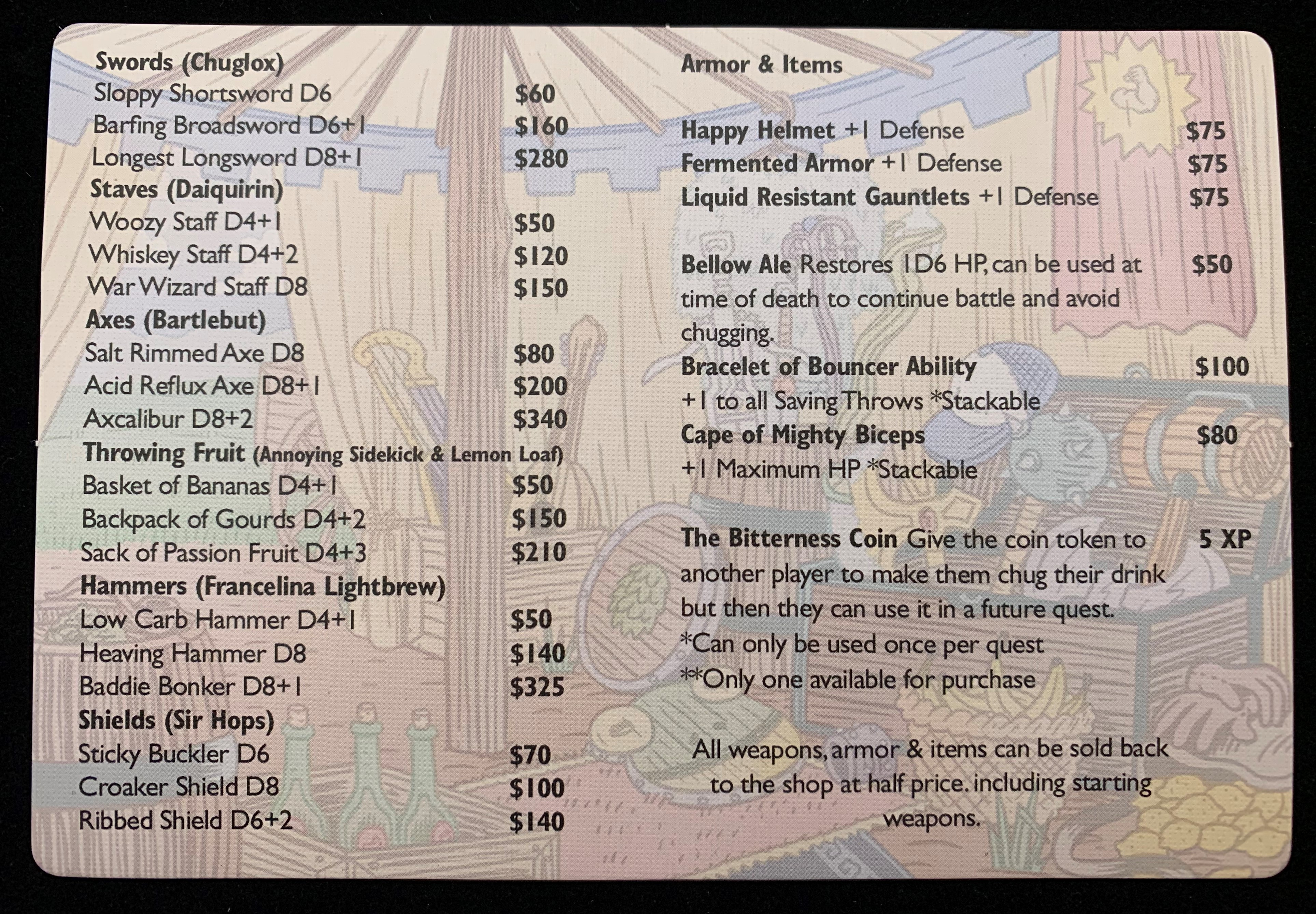
- As players gain items and coins, they may visit the shop purchase new goods and sell off unused gear.
- Selling Items: If a player has collected an item on a quest or is no longer using their starting gear, they can sell it back to the shop for half the printed value (if the item is listed).
- Buy Items: The player will turn in coins (or XP for one specific item) to collect the new item. If the item is a weapon, it must be in the same weapon tree as the weapon they started off the game with. Meaning, if your hero started with a sword, they may only buy swords; if they started with a staff, they may only buy staves.
- Any changes to your gear should be recorded on your character sheet.
- Heal Up
- After each Quest Deck, heroes heal to full health.
- Alternate Taking Turns Resolving Drawn Quest Cards until all Quests in a Deck have been Drawn
- Quest Cards will typically require the player to perform a dice roll based on a stat on their character sheet. Quest Cards are broken into two categories:
- Monster Cards
- Monster Cards will result in one-on-one combat with the enemies stats listed at the bottom of the Quest Card. The player must fight the enemy depleting their health to zero while also staying alive. The player to your right will control the monster rolls. Monster Card stats are:
- Hit Points (HP) indicated by a heart and number.
- Attack indicated by an axe and dice+number; attacking will involve rolling the shown die and adding the any modifiers you may have to it.
- Defense Rating indicated by a shield and number. Defense in this game is treated like damage reduction unlike target to hit numbers in most RPGs.
- Combat flow is as follows:
- At the start of combat, both combatants roll a D6 and whoever rolls the highest attacks first (hero wins ties).
- The first attacker will roll the D# for their weapon adding any modifiers listed, subtract the defenders defense rating from your attack value, and reduce the target's health by the resulting value.
- (Attack Die Value + Modifier) - Target Defense Rating = Damage to Target Health
- The other attacker will perform the attack steps described above.
- Combat alternates like this until one target hits 0 health.
- If the player wins combat, they are awarded the XP (drink symbol) and Coin (coin symbol) provided on the Monster Card. If the player loses combat, they must chug the rest of their drink. Chugging happens once per Quest deck; future losses on the same Quest Deck requires 3 swigs from your drink.
- Monster Cards will result in one-on-one combat with the enemies stats listed at the bottom of the Quest Card. The player must fight the enemy depleting their health to zero while also staying alive. The player to your right will control the monster rolls. Monster Card stats are:
- Event Cards
- Most Event Cards will list a Saving Throw the player must perform and what the outcome is if successful or unsuccessful. Players will roll all three of the dice and add together the rolled values. You are successful if the total is equal to or less than the listed Saving Throw for your character; otherwise, you fail. When successful, you may obtain items, XP/Coins, stat increases, or gain access to additional uses of abilities. When you fail, you will receive the listed penalty.
- There are a few Event Cards simply require an action to be performed or a single die roll.
- Monster Cards
- Quest Cards will typically require the player to perform a dice roll based on a stat on their character sheet. Quest Cards are broken into two categories:
Quest Duration/Healing
So in the rules, it states that Heroes are healed in between quests.
End Game
Whoever has earned the most XP by the end of the game is declared the Drinking Quest Champion (assuming they remember in the morning). Everyone wins if everyone is safe afterwards.
Hero Stats
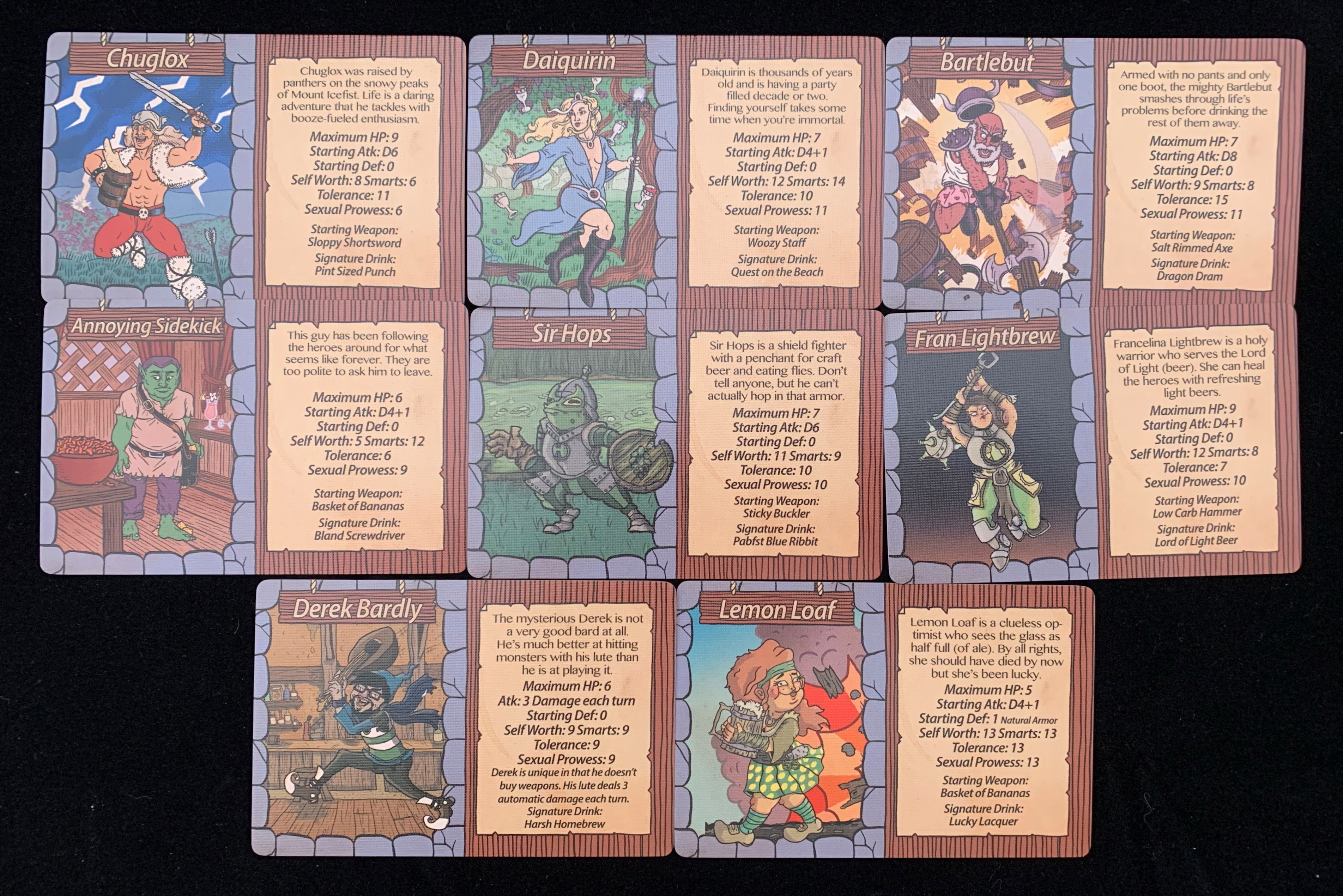 Characters are provided with a set of stats that represent traits about their character. Here is a breakdown of the character sheets.
Characters are provided with a set of stats that represent traits about their character. Here is a breakdown of the character sheets.
- Player Name: This is your name.
- Hero Name: This is the Hero names from the card, though you can certain change this if you have a better name in mind.
- HP: You will track your current HPs which only decreased during Quest Cards or player abilities; HP are restored after each Quest Deck. You will also track Maximum Health, which is what you will restore to.
- Chugs: This is just used to keep track of how many times you have had to Chug your drink.
- XP: Unlike in RPGs, this is purely used for tracking your victory points and is what determines the winner. There is one item you can exchange XP to buy.
- Attack: This will show you the die you will roll when attacking. Heroes come with a starting weapon, but this will be upgraded throughout the game if you pick up new weapons. You can only use one weapon so sell off your old gear.
- Defense: This is essentially the number you will reduce incoming attacked by. So if you have a 2 Defense and are attacked for 5 damage, you will only lose 3 health (5-2).
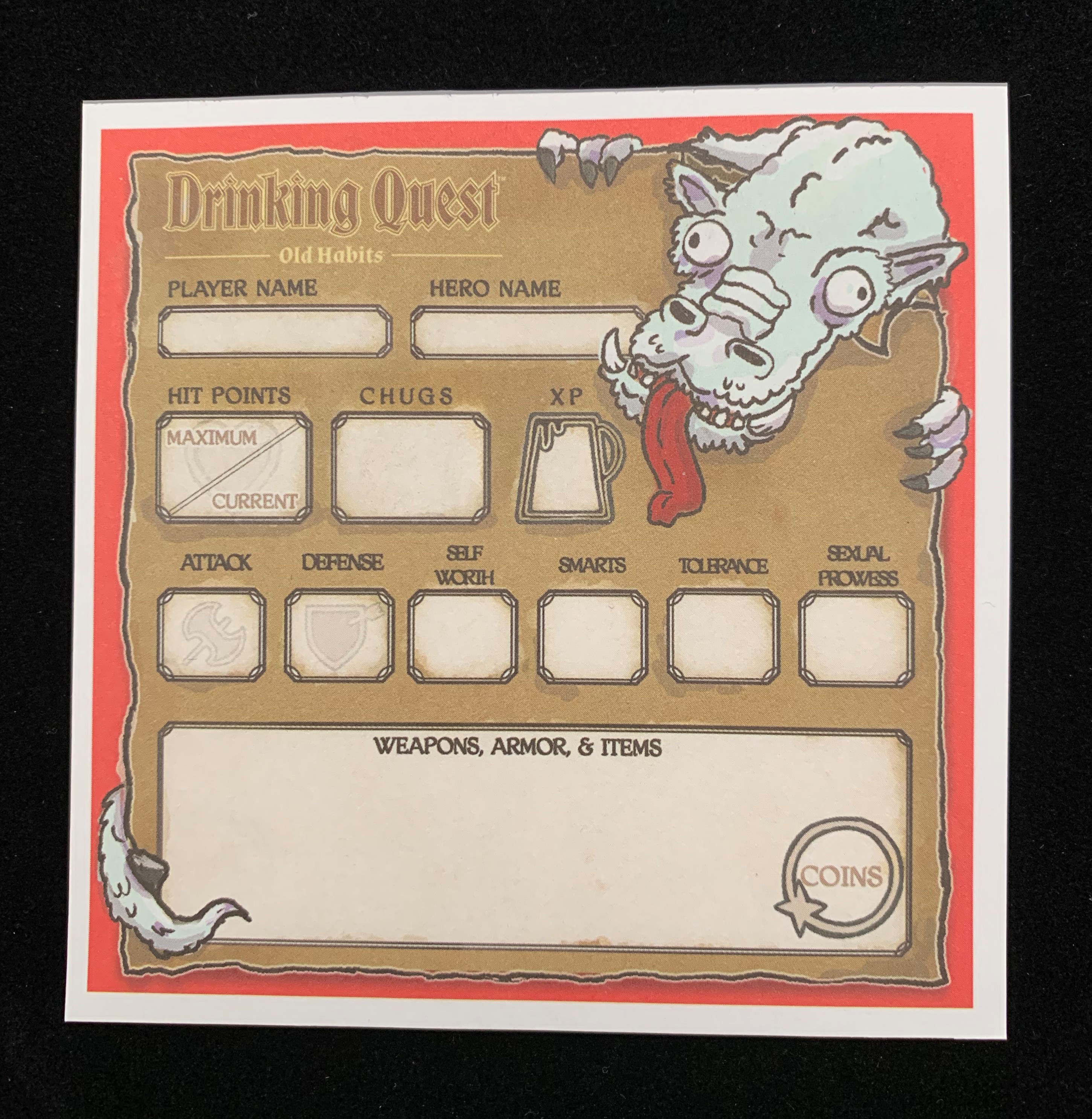 Saving Throws: These 4 values are used as target numbers for some event cards. Essentially, you want to roll equal or less than these to be successful.
Saving Throws: These 4 values are used as target numbers for some event cards. Essentially, you want to roll equal or less than these to be successful.
- Self-Worth: This is essentially Wisdom in D&D.
- Smarts: This is essentially Intelligence.
- Tolerance: This is essentially Constitution.
- Sexual Prowess: This is essentially Charisma.
There are Quest Cards that can alter each of the values; it is important to try to upgrade early as possible since each Quest Deck becomes more difficult.
Each character will also have their signature drink that provides an ability that is used a certain number of times per quest or game. A few abilities include:
- Lord of Light Beer: Twice per game, when you hit 0 HP, you may restore to 2 HP.
- Quest on the Beach: Once per quest, deal 3 points of damage to a target.
- Pint Sized Punch: Once per quest, you have inspire another player to Chug the rest of their drink.
Variants
The game provides three variants the players can use if they want a little change.
Designated Game Master
This mode is intended for use if you happen to have an extra player or even someone who is opting not to drink (though this isn't a requirement either). Basically, you have a dedicated person who reads the cards and controls the monsters. I honestly would want to get my Dungeon Master hat on and actually build up the scenes and everything...I think this is totally how this mode should be played too.
Making It a Double
The game is meant for 1-4 players, but you can have pairs of people teaming up to tackle the Quests increasing the player count to 8. They use a single character and basically act like one person with one brain and suffer the outcomes together. I honestly don't know how much this mode would really be used beyond when you simply have a larger group that all want to play, but I like that they listed it none the less.
Bladder Burster Rule
This mode targets those not drinking alcohol though it could really apply to all players. Essentially, the non-alcohol drinkers would drink glasses of water or something else they prefer. If they have to go to the restroom at any point during the game, they lose 5 coins each time. Since I don't drink alcohol, I would absolutely be playing this variant. I would remind anyone who uses this that it is still just a game, and if you REALLY have to go, just go because it isn't worth the pain of holding it over 5 coins especially when coins are handed out pretty generously for successful combat.
Final Thoughts
I think this is a clever Beer and Pretzels game that is clearly focused on being fun for everyone regardless of their current Blood Alcohol Level. It is simple, doesn't require much setup, and filled with humor that will keep groups laughing. As a D&D player, I love the theme and appearance of the box art. I appreciate that it is trying to capture the essence of an RPG while keeping it light enough to keep all players involved. It is also easy to modify the game to have a more traditional RPG feel by simply switching over to the Game Master variant and allowing them to expand on the Quest Cards while encourage players to get into their character.
The only downside I could think of with the game is the Quest/Healing timing. Players fully heal in between Quest Decks, which have 12 cards. My concern would be what happens if in a 3 player game two players are knocked out very early; it leaves one player continuing through the deck themselves. This could present a balance issue. Sure, it is possible that the remaining player could get knocked out, but it is also possible since the game revolves around the luck of the die, they could simply run away with the rest of the deck. I think I would make a house rule that players may revive themselves in exchange for their XP. I just fear if you get knocked out early, you become disconnected from the game. With a game that is expected to run 1-2 hours, being knocked out on your first Quest Card means you could be sitting around for almost 30 minutes with nothing to do. It is possible the intention of the rules were to allow players to return in between Quest Cards drawn and not Quest Decks (the wording isn't clear about that), but if that were the intention, then there would be issues with the wording of the abilities that happen once per Quest. That is honestly the only issue I have with the game, and it is easily fixable by a house rule.
I really do like this game, and I feel this will be fun for the targeted market. This is not for your hardcore RPG players because it is meant to be easy and straightforward. While the game is targeted for 21+, it can be played by somewhat younger audiences without the use of alcohol; the 21+ is to protect the company. If you like classic feeling RPGs but don't have time for something that large or want to have some fun while at the bar, consider looking into the Drinking Quest series of games. 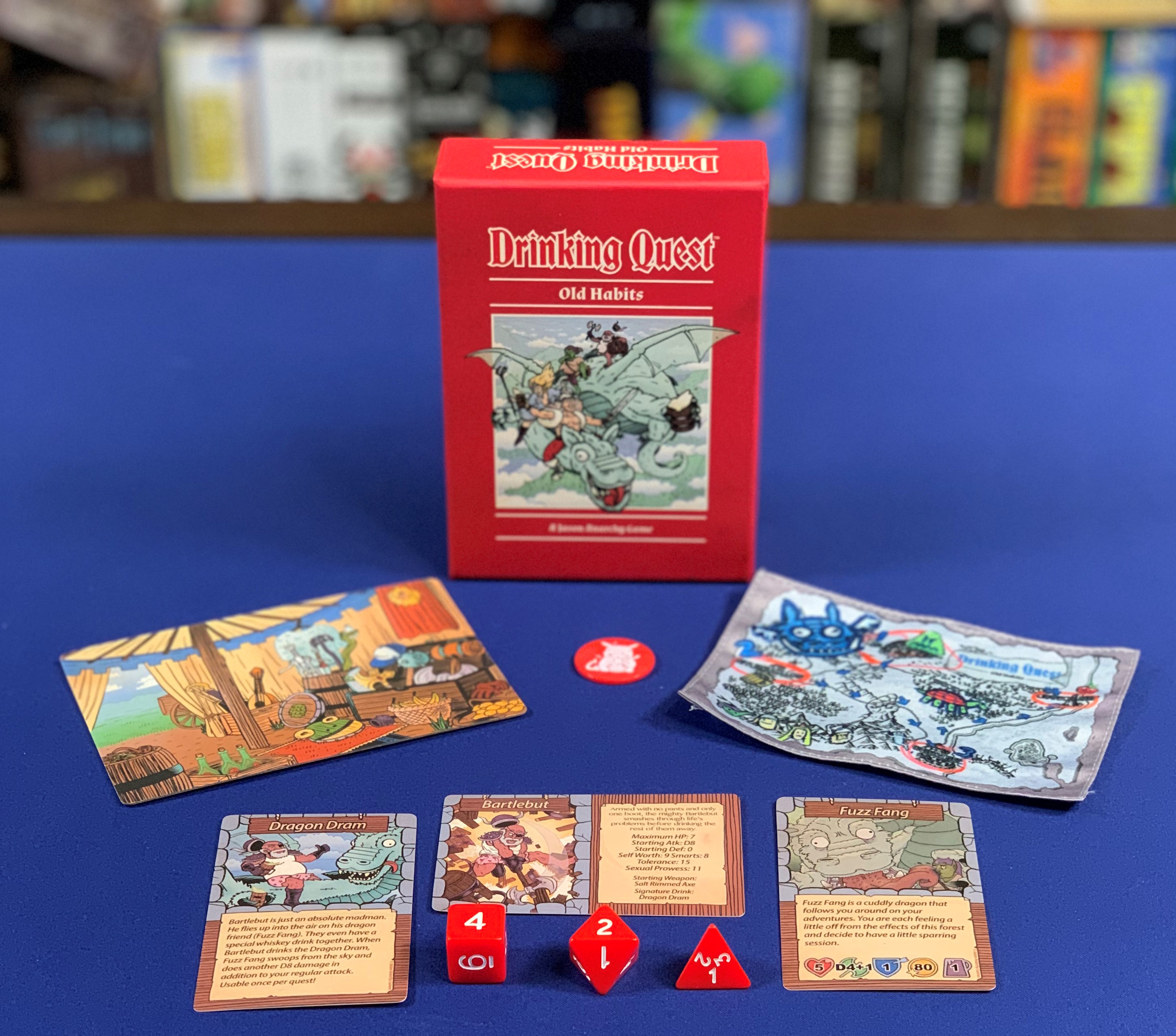
If you are really interested in the series, there is an active Kickstarter for a collection of all six games in the Drinking Quest series called Drinking Quest: Six Pack.
Links/Media
Drinking Quest: Old Habits Board Game Geek Page
Drinking Quest: Six Pack Collection Kickstarter Page
Disclosure
We received the product in order to write an honest review; all reviews reflect the honest opinions of the writer.
WVGamers is a participant in the Amazon Services LLC Associates Program, an affiliate advertising program designed to provide a means for sites to earn advertising fees by advertising and linking to Amazon.com.
